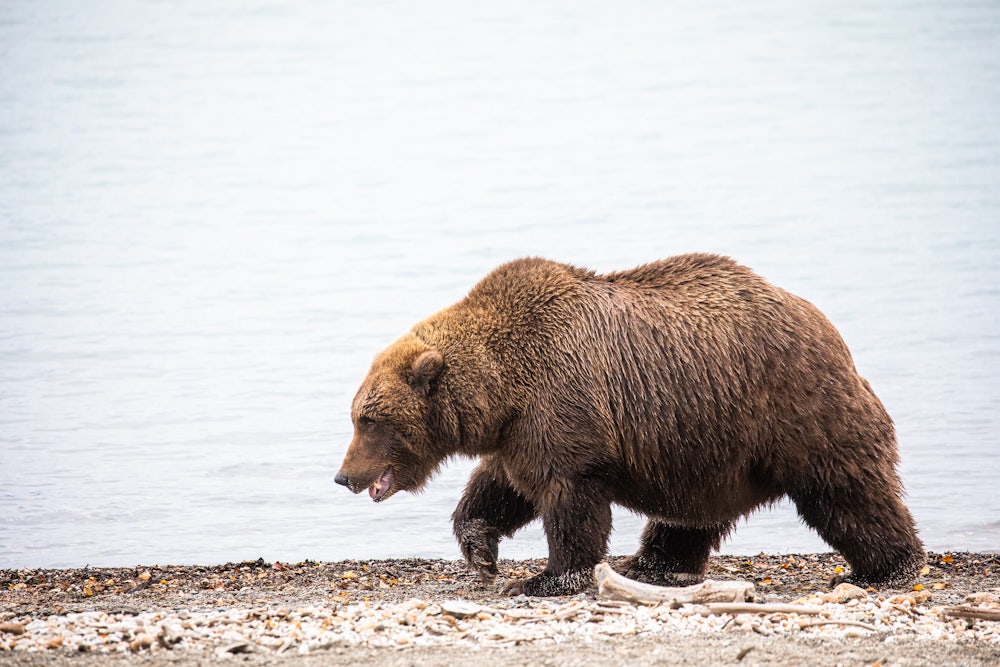Every October for the past five years, Fat Bear Week has showcased some of the healthiest, hungriest, and chonkiest bears in Katmai National Park and Preserve, a four-million-acre expanse of wilderness in southern Alaska.
All summer, bear enthusiasts watch the coastal brown bears splash through Brooks River and feast on ruby-red sockeye salmon. Every fall the bears grow impossibly fat—some doubling in size. It’s crucial preparation for winter hibernation, which bears survive by burning through a third of their body mass. During Fat Bear Week, viewers fill out brackets and vote on the chubbiest bears until the final showdown, when one ursine champion is crowned the fattest of them all.
But this summer, viewers saw some unusual activity on the Explore.org webcams. Sometimes the bears stopped feasting, and simply wallowed in the water.
That’s because record-high temperatures scorched the entire state of Alaska this summer. Even the water the bears cooled off in hit 70 degrees on some days. The sockeye salmon didn’t swim through the sweltering water, likely staying in a cooler lake downstream while the heat lasted. “It’s not just like, it was hot and we broke a few records,” Mike Fitz told me. “Never-before-seen temperatures happened in Bristol Bay.”
Fitz is a former Katmai park ranger and the resident naturalist at Explore.org. He is, in other words, the Fat Bear expert. He sees Fat Bear Week as “a rare glimmer of hope and ecosystem health in a world really that is wounded by climate change and extinction.”
“Katmai is one of those rare places where the ecosystem’s potential is fully realized,” Fitz said. “But that’s not necessarily guaranteed for the future.”
The bears (and salmon) of Katmai seem to have weathered the soaring temperatures this year. But as the climate continues to change, the park and its beloved inhabitants will likely start seeing wide-ranging effects. The Arctic is the fastest changing environment in the world, warming twice as fast as the rest of the globe. The bears of Katmai live well below the Arctic Circle, but as sea ice melts, polar bears are hunting on land more—and competing with brown bears for food.
The brown bears’ diets are already changing because of climate change. Brown bears on Kodiak Island, across the water from Katmai, have begun eating more berries as changing conditions allow the berries to ripen later in the year. That interferes with the timeline for eating salmon, which could in turn affect the ecosystems in places like Katmai. “Bears are a major vector to transfer salmon nutrients into different parts of a watershed,” Fitz said. “Because they carry carcasses into the forest, they carry salmon in their digestive tracts and then as they deposit them in urine and scat, they’re spreading salmon nutrients throughout much of the area.”
The salmon that feed bears and fertilize forests could be at risk from climate change as well. So far in Katmai, those salmon are doing great—“gangbusters,” as Fitz puts it. The 2018 sockeye salmon run in Bristol Bay was the largest on record, and 2019 wasn’t far behind. But for the salmon lingering in a downstream lake this summer while Brooks River heated up, these new extremes could be fatal. Sockeye salmon process the oxygen in water more efficiently the colder it is, so they need more oxygen when the water is hotter. But warmer water contains less dissolved oxygen.
And there could be problems for salmon further downstream. Oceans are absorbing about 90 percent of the additional heat generated by climate change, which will likely have a substantial negative effect on phytoplankton and zooplankton—the base of the aquatic food pyramid. With less food, salmon populations could plummet. “Their food and their ocean conditions could change quite drastically,” Fitz explains. “If the oceans aren’t healthy, then salmon aren’t going to come back.”
Daniel Schneider, a biologist, environmental consultant, and longtime Fat Bear fan, points to rapid changes in British Columbia, on the other side of the Gulf of Alaska. There, brown bears are starving after one of the worst salmon runs in that region’s history.

“I’d say fifteen, twenty years ago, they could have done a Fat Bear Week out in British Columbia, but they can’t do that now because the bears are basically starving to death,” Schneider told me.
Changes in temperature and environment also affect the bears themselves. The fatter the bear, the easier it is to get overheated, which means they have to cool off and stop eating. And rising temperatures aren’t only a summertime threat. Warmer winter temperatures could also endanger the bears. If warmer winters reduce the snow pack, that means the bears’ dens have less insulation. The insulation provided by snow protects bears from the increasingly wild temperature fluctuations outside their dens.
For now, Katmai’s bears are hefty and healthy as ever. No one knows how long that will last.
“Katmai is a beacon of health and productivity, which is just so rare in our world today,” Fitz said. “I think that helps to underscore even more why we need to protect these places.”
This piece has been corrected to reflect that while air temperatures near Brooks River reached 90 degrees this summer, the water temperature stood at 70 degrees. The piece originally misstated that the water temperature hit 90 degrees.
